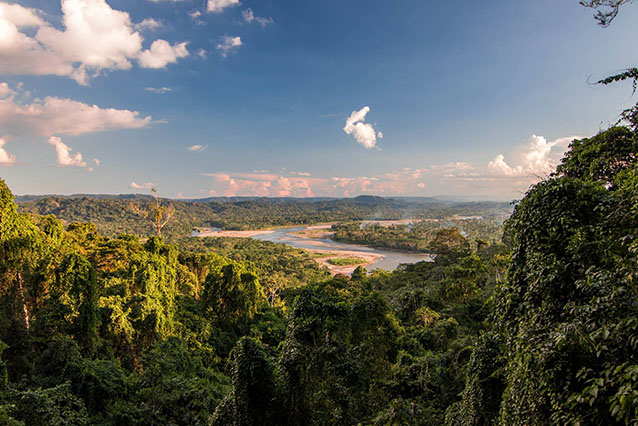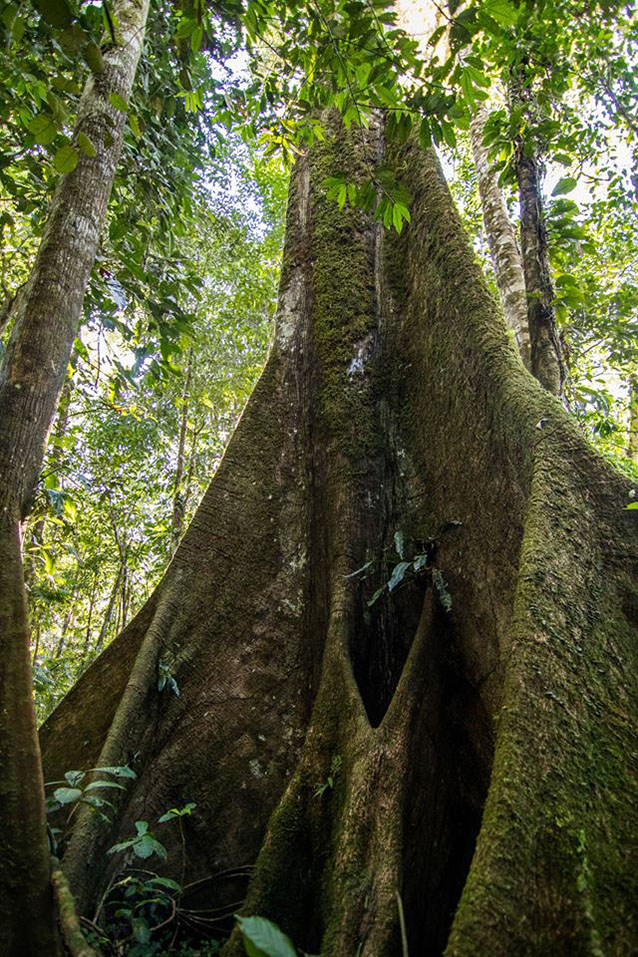I take a fair amount of pride in calling myself a “Colorado Girl”. I am a huge fan of the Broncos, I drive a Jeep, I snowboard in the winter, and I have climbed 5 of Colorado’s 14,000 peaks, just to name a few of my stereotypical Colorado traits. Perhaps the most stereotypical trait of all is that I absolutely love to hike, which is why I was looking forward to the opportunities for hiking in the Amazon while in Ecuador. Little did I know, this would be one of the most challenging parts of my experience abroad, but also one of the most rewarding. When you are used to hiking in the high-altitude, alpine environment of Colorado, embarking on a hike through the Amazon Rainforest can feel like walking on another planet.
As an avid hiker, I didn’t really give a second thought to going on a hike in Amazon. It seemed like a fairly straightforward activity that I was used to doing back home. When I was looking on the website of the lodge we were staying at leading up to the trip, I was excited to see hiking listed as one of the opportunities. Seeing huge, 700 year old trees in primary growth Amazon rainforest? Sign me up! I love looking at old trees, I love hiking, and I love the idea of seeing untouched, pristine Amazon rainforest. On paper, this seemed like my ideal afternoon in the Amazon. Hiking would be a welcome activity to feel a little more at home.
I should first get a little more specific about the type of hiking I am used to. At home, the hikes I do are usually at an altitude of at least 9,000 feet, all the way up to the 14,000 foot peaks that Colorado is known for. Some of my favorite hikes are in Rocky Mountain National Park, where my favorite destinations are usually some sort of high alpine lake. The trails in the park wind through coniferous forests, usually with some tall, spindly lodgepole pines. The forest is not terribly dense here, and looking around, it isn’t hard to pick out the main trail or even smaller trails that people have made themselves. There are sweeping vistas with amazing views of Longs Peak and the valleys below, and the sky is visible any time you look up. The air is crisp and lacking oxygen, which is how I have always preferred my air. In the winter, or even on the tallest peaks in the summer, it hurts to breathe this air into your lungs and leaves your face feeling raw.
This was not unlike our first experience hiking in Ecuador. Several days before arriving in the Amazon, we had the opportunity to climb up to almost 16,000 ft. on Cotopaxi. Cotopaxi, like any mountain in Colorado, was a beast in its own right. Despite the fact that this was the second highest active volcano on Earth, I didn’t feel too out of place while we were hiking. The feeling of breathlessness, the cold air that bites at your skin, and the dramatic scenery of the landscape below felt exactly like being on a 14er in Colorado. If I closed my eyes, I could imagine that I was standing on the pinnacle of Torrey’s Peak like I had been just weeks prior to this trip. It made the 3,240 miles from home feel much smaller.
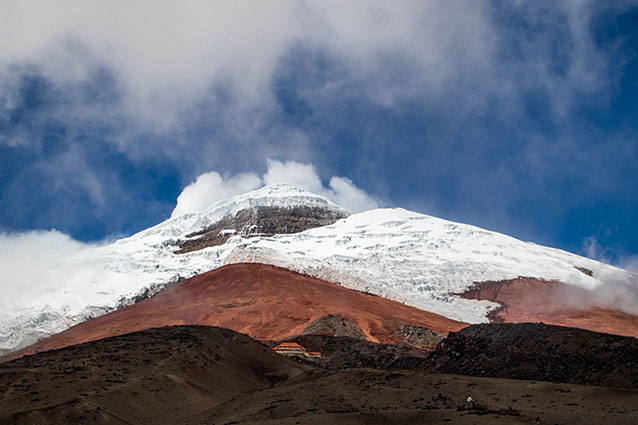
I would soon learn that hiking in the Amazon was another beast entirely. Even before our hike, I should have known that I was getting myself into something I was not prepared for. Simply walking from the cabin we were staying at to the lodge resulted in being sweatier than I care to admit, which was clue number one that I would be highly uncomfortable. When our guides gave us knee-high boots to wear so that we didn’t get any of the horrifying and dangerous bugs in our shoes, that should have been clue number two that this was far more intense that I was anticipating. Clue number three that it was about to get real was when, at the beginning of the hike, Jaime, our guide, told us very firmly to not touch anything without seeing him touch it first. At this point, my inner monologue was something along the lines of “What the hell am I doing, this place is literally out to kill us.”
But like most unsuspecting victims of horror movies, those clues did not deter me and I happily followed our cheerful guide Jaime into the darkness of the forest. And I do not exaggerate when I say darkness. Immediately I was shocked at how much darker it was once we entered the forest due to the incredibly dense canopy above us. I remember looking up, and feeling disoriented because I couldn’t see the sky like I am so used to when hiking at home. Being in the real thick of the forest also made it feel ten times more humid than it already was. When you’re used to air that literally hurts your face, feeling like you’re drowning when you’re standing on dry land is a highly unpleasant experience. The hike was by no means strenuous at this point, but I was already drenched in sweat which only added to my feelings of uneasiness. Every time a plant brushed up against my skin, I was imagining all of the ways that it could make me deathly ill.
 One of the most unique and uncomfortable feelings I experienced on this hike was one
I never expected: claustrophobia and very intense fear. After hiking for awhile, I
started to feel extremely uneasy. I was confused at first, and as we kept moving I
tried to analyze what could possibly be making me feel this anxious at this point
in the hike. I soon realized that it was the sheer density of the forest itself. I
have always felt uncomfortable in small or tight spaces, especially if the way out
is not clear to me or hard to access. This is something that I have never experienced
while outside hiking, something that I love to do. I have certainly never experienced
it in the coniferous forests of Colorado.
One of the most unique and uncomfortable feelings I experienced on this hike was one
I never expected: claustrophobia and very intense fear. After hiking for awhile, I
started to feel extremely uneasy. I was confused at first, and as we kept moving I
tried to analyze what could possibly be making me feel this anxious at this point
in the hike. I soon realized that it was the sheer density of the forest itself. I
have always felt uncomfortable in small or tight spaces, especially if the way out
is not clear to me or hard to access. This is something that I have never experienced
while outside hiking, something that I love to do. I have certainly never experienced
it in the coniferous forests of Colorado.
At one point it felt like the forest was closing in around me. No matter the direction I looked, all I could see was insanely dense forest. It felt like being swallowed alive. I had absolutely no sense of direction, no sense of how high we were, and certainly no sense of where we were going.
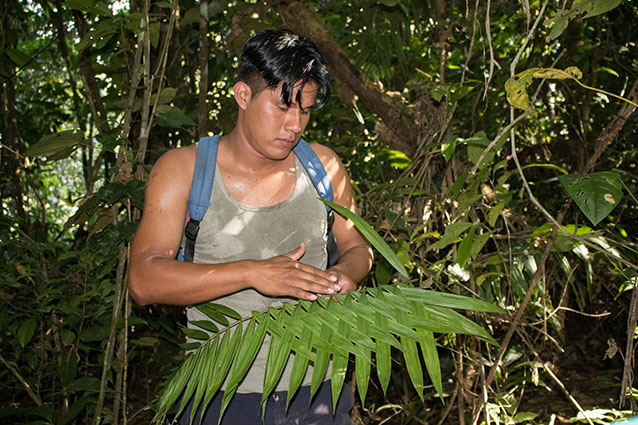 Jaime could detect trails that I never would have noticed, and I felt like we were
walking in circles. Soon, I started to internally freak out (luckily, I’m rather cool
under pressure so no one realized that I was losing my mind). All I could tell myself
was, “If Jaime walks too fast, or if you get lost, you absolutely will die out here.
There is no way you could ever find your way out of this death trap forest. You’ll
wander around forever until you die of starvation, or you’ll stung by a bullet ant
and eaten by a jaguar.” While my mind may have a flair for the dramatic, I started
to run through scenarios of what would happen if I got lost. None of them ended well.
Jaime could detect trails that I never would have noticed, and I felt like we were
walking in circles. Soon, I started to internally freak out (luckily, I’m rather cool
under pressure so no one realized that I was losing my mind). All I could tell myself
was, “If Jaime walks too fast, or if you get lost, you absolutely will die out here.
There is no way you could ever find your way out of this death trap forest. You’ll
wander around forever until you die of starvation, or you’ll stung by a bullet ant
and eaten by a jaguar.” While my mind may have a flair for the dramatic, I started
to run through scenarios of what would happen if I got lost. None of them ended well.
Luckily, none of the scenarios I imagined came true, and we all made it out alive. Despite how uncomfortable I was throughout the hike, I don’t want to neglect the parts of the hike that made it amazing. Jaime told us all about how the indigenous people used a variety of plants and insects from the forest for medicinal purposes or for building houses. He rubbed some mud on my face like what you would expect at a high end spa, and made Makayla a crown out of a palm leaf. These were some of the best moments of the hike, when I momentarily forgot that for every plant that can heal your bug bites, there were plenty of bugs out there who would be happy to do the biting.
When we finally arrived at one of the ancient trees, this was another moment where I could stop worrying about the poisonous plants rubbing up against me. Being in the presence of a tree so old and enormous is one of the best feelings I think someone can have.
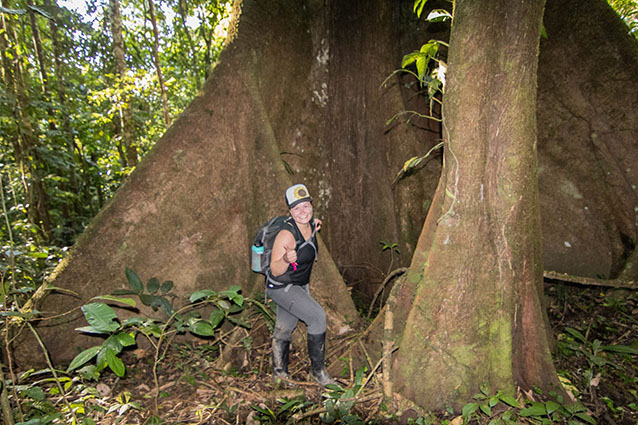 Much like being beneath the Giant Sequoias in California, being near these trees gives
you a real dose of perspective on your life and your role on the planet. I can only
imagine the stories this tree would tell if only it had the chance. It gives you appreciation
for the natural world and the wonderful things that can happen in it, and reminds
you that this is worth protecting. I think that this was one of the most valuable
moments of the trip for me, and it was well worth feeling horribly uncomfortable for.
Much like being beneath the Giant Sequoias in California, being near these trees gives
you a real dose of perspective on your life and your role on the planet. I can only
imagine the stories this tree would tell if only it had the chance. It gives you appreciation
for the natural world and the wonderful things that can happen in it, and reminds
you that this is worth protecting. I think that this was one of the most valuable
moments of the trip for me, and it was well worth feeling horribly uncomfortable for.
The best moment of the hike, even better than the ancient tree, was reaching an overlook towards the end of our hike. Finally, something I was used to: hiking to a stunning view and taking it all in. The view overlooked the Napo river as it meandered through the forest in the golden afternoon light. A few trails of smoke were rising through the canopy, and huge puffy clouds were building in the distance. From here, you could really begin to appreciate the scale of the Amazon. Dense, green canopy stretched as far as the eye could see.
While we stood here, I remember feeling immensely grateful that I was able to see this amazing place before it is gone. I’ll be able to tell my kids, “I saw it. I was there.” According to the World Wildlife Fund, 17% of the Amazon rainforest is already gone thanks to deforestation. They say that in 30 years, it could all be gone if current trends continue. And for what? We have destroyed this forest for cattle ranches, for agricultural fields, and for mineral extraction. These are huge industries that can feel impossible to stand up to. I felt for a moment how I think a lot of environmentalists feel at some point: what is the point? How can I possibly do anything to stop this? How can one person make a difference? But for every one of those thoughts, there are thoughts like the ones we have underneath giant trees or standing on a scenic overlook: This place matters. This place is worth protecting. Rather than feeling defeated, as it is very easy to do, I left the Amazon Rainforest feeling inspired and motivated.
I couldn’t help but be reminded of one of my all time favorite quotes while we stood there watching the forest:
“Unless someone like you cares a whole awful lot, nothing is going to get better.
It’s not.” -Dr. Suess (The Lorax)